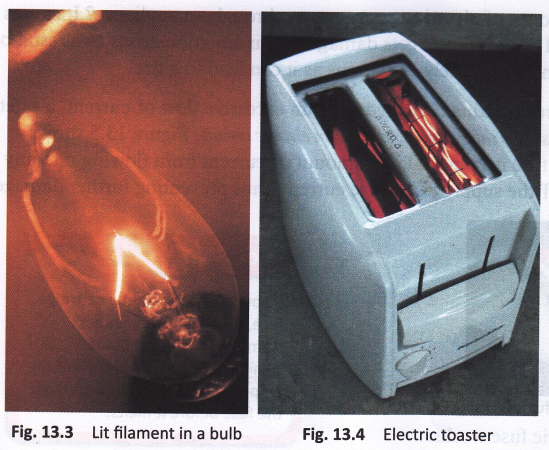Heating Effect Of Electric Current
Try touching a torch bulb that is lit and another that is not. Be careful when you touch the lit bulb. Do you feel it is hot to touch? Why do you think it is so?
In a bulb, an electric current passes through a very thin wire made of a special material (such as tungsten) called the filament. When the bulb is switched on, the filament gets heated. This is due to the heating effect of the electric current.
 The heating effect of current is used in several appliances, which include electric toasters, electric irons, hot plates, electric hairdryers, and electric ovens. These appliances contain tightly wound coils, called elements. An element heats up when an electric current passes through it. In many electrical appliances, as the element is not covered, it can be identified by its dull red glow when the appliance is on.
The heating effect of current is used in several appliances, which include electric toasters, electric irons, hot plates, electric hairdryers, and electric ovens. These appliances contain tightly wound coils, called elements. An element heats up when an electric current passes through it. In many electrical appliances, as the element is not covered, it can be identified by its dull red glow when the appliance is on.
Read More:
Activity
Aim: To show the heating effect of current (adult supervision required)
Materials needed: 1.5 V cell, two pieces of wire, a small torch bulb, and insulation tape/adhesive tape Method:
- Strip the insulation at both ends of the two wires so that about 1 cm of the metal portion is exposed.
- Connect the negative end of the cell to the threaded portion of the bulb with one of the wires.
- Secure both ends with the insulation/adhesive tape.
- Connect the positive end of the cell to the bottom portion of the bulb with the second piece of wire.
- Secure both ends with the insulation/adhesive tape.
- You will find that the bulb glows. If it does not, check to see if the connections are tight or need to be tightened. Adjust the connections till the bulb glows.
- Touch the bulb to see how hot it is just when the connections are complete.
- Leave this arrangement (with the bulb glowing) for some time and then touch the bulb.
Observation: Bulb is a little warmer now than at the beginning.
Conclusion: This is because the passage of electric current heats it up.
Note: Follow the precautions given below while doing this activity.
- Touch only the insulated parts of the wire connected to the terminals of the cell.
- Do not perform the activity near inflammable materials such as kerosene, petrol, or the gas cylinder.
- Do not use a cell of a higher voltage than specified (1.5 V).
- Do not use the plug points of your house/school.